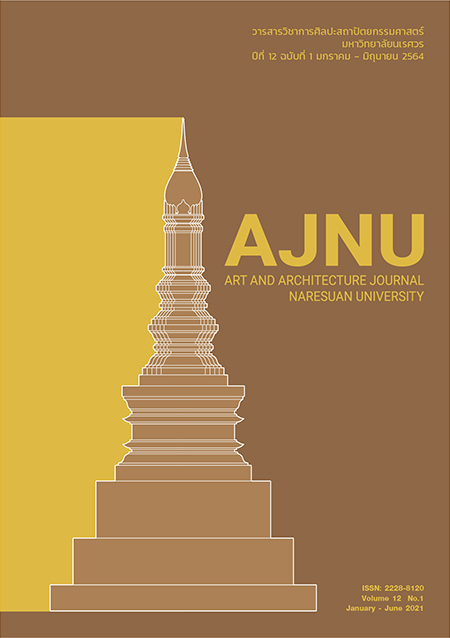Thailand Design and Development of a Drinking Water Bottle with a Multipurpose Medicine Storage Box for the Elderly
Main Article Content
Abstract
The number of elderly people in Thailand is increasing, which is a result of the changes in fertility and mortality that is affecting the age structure of the Thai population. Furthermore, the elderly tend to experience a decline of efficiency in their ability to do simple daily activities that affects their lifestyle. Most of the elderly must also take medication on a regular basis. However, they may sometimes forget to take their medication not only at home, but also when they go elsewhere. Therefore, they may have some difficulty separating the medicine and finding drinking water when they have to take their medication immediately. For these reasons, this research aimed to 1) study the problems and requirements to be used as a guideline to design and develop a drinking water bottle with a multipurpose medicine storage box for the elderly, 2) design and develop the aforesaid water bottle, and 3) evaluate the efficiency and satisfaction on the design and development of the water bottle. One hundred and five samples participated in the study. The research tools included an in-depth interview and questionnaire, and the gathered data was analyzed by the mean and standard deviation. The study showed that the elderly accepted the medicine storage box, as it was convenient for them to drink water immediately after consuming some medicine. The storage box had three sections; one each for breakfast, lunch, and dinner. Moreover, a label or sign indicated when the individual had to take that respective medicine. In addition, there was a device to separate the medicines when there were too many to take at one time. The product structure was made of polycarbonate and the drinking water bottle had a capacity of 250 millimeters. In this design, the product was created based on the concept of the cross-sectional area like a human kidney, and the bottle’s shape was designed based on a portable stainless steel whisky bottle. The results showed that the efficiency and satisfaction of the elderly was at a high level (=4.27; S.D=0.40) in the function and benefit, pattern and beauty, material, and safety.
Article Details
References
เกษร สําเภาทอง .(2550). ครอบครัวกับการดูแลและสงเสริมสุขภาพผูสูงอายุ. สืบคนเมื่อ 28 พฤศจิกายน 2562, จาก
http://www.nurse.tu.ac.th/KM_NURSETU.htm
เทียนทิพย์ เดียวกี่. (2561). รับมือสังคมสูงวัย. สืบคนเมื่อ 30 พฤศจิกายน 2562, จาก https://www.thaihealth.or.th/
Content/43716-รับมือสังคมสูงวัย.html
ธิดารัตน์ เอี่ยมศิริรักษ์. (2548). การสื่อสารการตลาดที่มีผลต่อการเลือกซื้อสบู่สมุนไพรชนิดก้อนของผู้บริโภคใน
อำเภอเมือง จังหวัดเชียงใหม่. การค้นคว้าอิสระบริหารธุรกิจมหาบัณฑิต มหาวิทยาลัยเชียงใหม่, เชียงใหม่.
ประชิด ทิณบุตร. (2531). การออกแบบบรรจุภัณฑ์. กรุงเทพมหานคร: โอ.เอส.พริ้นติ้งเฮ้าส์.
ปรภัทร จิตรากุล. (2561). ผู้สูงวัยรับประทานยา เรื่องธรรมดาที่ไม่ควรมองข้าม. สืบคนเมื่อ 27 พฤศจิกายน 2562, จาก
https://www.thaihealth.or.th/Content/46100-ผู้สูงวัยรับประทานยา เรื่องธรรมดาที่ไม่ควรมองข้าม.html
พรพิมล พจนาพิมล. (2551). การศึกษาและพัฒนากลองยาอิเล็กทรอนิกสสําหรับยาชนิดเม็ดของผูสูงอายุที่มีโรคประจําตัว.
หลักสูตรปริญญาศิลปกรรมศาสตรมหาบัณฑิต สาขาวิชานวัตกรรมการออกแบบ บัณฑิตวิทยาลัย
มหาวิทยาลัยศรีนครินทรวิโรฒ, กรุงเทพมหานคร.
Hacker, M.C., Krieghoff, J., & Mikos, A.G. (2019). Principles of Regenerative Medicine. (3rd ed). San Diego:
Elsevier Academic Press.
Shivsharan U.S., Raut E.S. & Shaikh Z.M. (2014). Packaging of Cosmetics: A review. Journal of
Pharmaceutical and Scientific Innovation. 3 (4), 287-293.
Thackston, K., Gavarnie, J., Ousts, A., & Pham, A. (2013). Consumer Purchasing Based on Packaging
Structural Design/Product Visual Display in a Retail Environment. Retrieved May 2, 2016, from http://www.andrewd.ces.clemson.edu/courses/cpsc412/fall11/teams/.../group7.pdf
Weinel, R. H., & Newman, L. S. (1976). Increasing attitude-behavior correspondence by broadening the
scope of the behavioral measure. Journal of Personality and Social Psychology. 33. 793-802.


